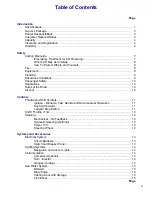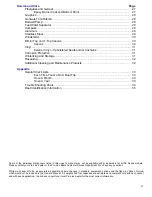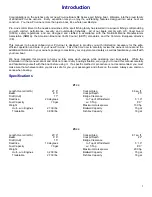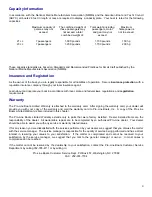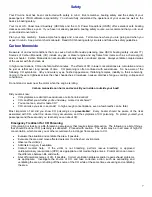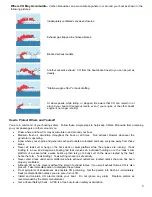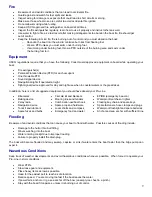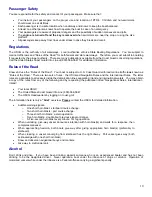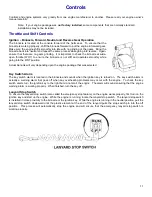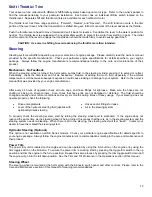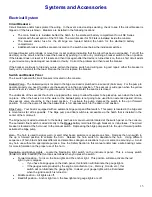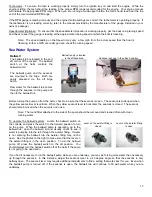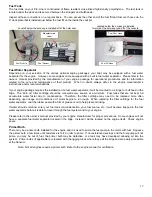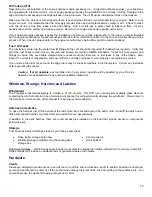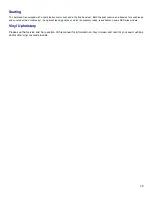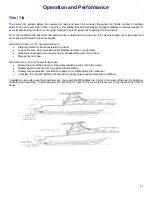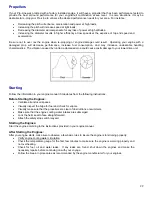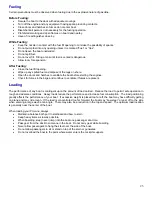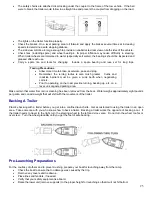
12
Shift / Throttle / Trim
Your vessel can be ordered with different shift/throttle systems based upon motor type. Refer to the owner's packet to
find the manual pertaining to your particular installation. Each motor has an individual tilt/trim switch located on the
throttle lever. Separate shift and throttle controls are available for each outboard motor.
The throttle lever has three range positions: “Forward”, “Neutral”, and “Reverse”. The shift function occurs in the first
portion of the lever travel. After the transmission is shifted into gear, further movement of the lever advances the throttle.
Push the throttle lever ahead to move forward and pull it back for reverse. Centralize the lever to the detent position for
neutral. The throttle lever is equipped with a neutral safety switch to prevent the motor from starting in gear. The initial
short movement of the lever to engage the transmission should be made firmly to avoid causing gear clash.
CAUTION: Use care in shifting to avoid advancing the throttle more than intended.
Steering
Steering systems will differ depending upon your selection of engine package. Please carefully read the owner’s manual
provided by the specific manufacturer. Check your particular engine specifications for details specific to your engine
package. Always follow the engine manufacturer’s recommendations relating to the care and maintenance of their
product.
Mechanical – No Feedback
When the steering wheel is turned, the helm pump pumps fluid to the steering cylinder causing it to extend or retract.
Periodically, check the fluid level and fill as necessary. Beware of adding too much fluid, especially if the ambient
temperature is cold because subsequent expansion could cause leaking or damage to your system. Refer to the owner’s
manual that was provided by your engine manufacturer.
After every 24 hours of operation check all nuts, caps, and hose fittings for tightness. Make sure the hoses are not
chafing or kinking on sharp corners. Also, check that hose ends are not damaged or distorted. The fluid should be
changed annually under normal conditions and every six months during times of heavy usage. If your steering does
not
operate properly, check the following:
Drive
entanglements
Hoses and/or fittings for leaks
Level of the hydraulic steering fluid (applies with
optional Hydraulic steering
Air in the steering system
To properly check the steering system, start by turning the steering wheel port to starboard. If the engine does not
respond the same time as the steering wheel is being turned, this means that there is air in the steering system and the
steering system needs re-bleeding. When there is air in the steering, the steering wheel will feel “loose”. Contact your
dealer to have them bleed the steering system.
Hydraulic Steering (Optional)
This option is not available on all SE Series models. Check your particular engine specifications for details specific to
your engine package. Always follow the engine manufacturer’s recommendations relating to the care and maintenance of
their product.
Power Trim
The power trim unit is located on the engine and can be operated by using the trim button on the engine or by using the
trim toggle switch on the binnacle. To ensure the power trim is working, start by pressing the toggle trim switch in the up
position and trim the engine to the full up position. Repeat the same process by pressing the trim toggle switch down and
the engine will go into the full down position. See the Trim and Tilt information in the Operations section of this manual.
Steering Wheel
The steering wheel is mounted at the helm along with the binnacle, switch panel and other controls. Please refer to the
Care and Maintenance section of this manual for cleaning recommendations.
Summary of Contents for 2012 21 CC
Page 6: ...2...

